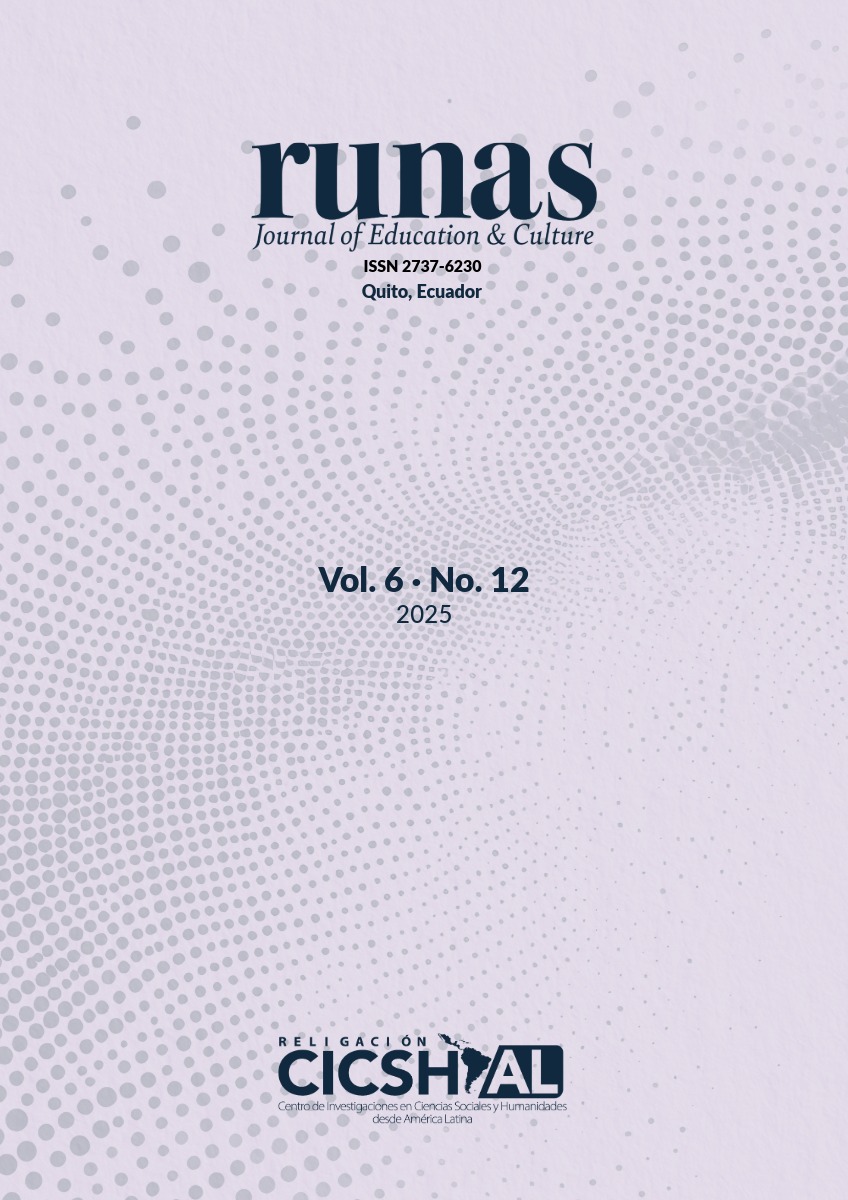Abstract
This literature review was conducted using a systematic methodology to investigate the role of neuropedagogical principles in enhancing second-language acquisition for elementary students. As well as the cognitive and emotional features of neuropedagogical approaches in early childhood development and teacher perceptions. Through the use of keywords, Boolean operators and exclusion criteria, a total of 17 scientific articles were selected for analysis. Four neuropedagogical strategies were found to encourage children to learn English as a foreign language: multisensory learning, technology and multimedia resources, Total Physical Response (TPR) and Project-Based Learning (PBL). It was concluded that neuropedagogical strategies encourage students to learn English by fostering active class participation and making vocabulary acquisition enjoyable. Neuropedagogical strategies were also effective in promoting brain plasticity and adaptability when acquiring new knowledge.
References
Abdi, A., & Canvus, N. (2019). Developing Electronic Device to Teach English as a Foreign Language: Educational Toy for Pre-Kindergarten Children. International Journal of Emerging Technology in Learning, Kassel, Germany, 14(22). https://doi.org/10.3991/ijet.v14i22.11747
Aisyah, S., & Novita, D. (2025). Teachers’ perception of the implementation of project-based learning in early childhood education in Indonesia. Congent Education, 12(1), 1-17. https://doi.org/10.1080/2331186X.2025.2458663
Barabanova, I., & Kazlauskiene, A. (2020). Neuropedagogy: preconditions for application of neuroscience results in the education process while providing feedback /. Techniumscience, 2, 112-122.
Chojak, M. (2018). Neuropedagogy as a Scientific Discipline: Interdisciplinary Description of the Theoretical Basis for the Development of a Research Field. International Journal of Educational and Pedagogical Sciences, 12(8), 1-4. https://doi.org/10.5281/zenodo.1474341
Co?ar, Z., & Orhan, R. (2019). Teaching Kindergarten Children English Vocabulary by Total Physical Response in Physical Education Courses. Journal of Physical Education and Sports Management, 6(2), 70-76. https://doi.org/10.15640/jpesm.v6n2a8
Davronbek, Y. (2023). System of Principles of Neuropedagogy. The European Journal of Education, (4), 126. https://doi.org/10.29013/EJEAP-23-4-126-129
Freire, R., León, M., Espin, L., & Maldonado, G. (2025). Teaching-learning strategies of English as a second language using aesthetic expressions. Pontificia Universidad Católica del Ecuador, Quito, Ecuador, 1(2), 1821-1839. https://doi.org/10.23857/pc.v10i2.9003
González, F., Cascales, A., & Gomariz, M. (2022). Neurodidactic strategies in the area of English Language in kindergarten and elementary education. Multidisciplinary Journal of Education, 15(31), 43-56.
Hernández, A. (2022). Neuropedagogy and neuroimaging. exto Livre, 15. https://doi.org/10.35699/1983-3652.2022.40453
Hossain, R., & Flint, S. (2015). The Effectiveness of Using Technology in English Language Classrooms in Government Primary Schools in Bangladesh. FIRE: Forum for International Research in Education, 2(5), 47-59.
Kamenická, J. (2022). Brain-Based TEFL. Faculty of Education of Constantine the Philosopher University.
Khairma, F., & Suryana, D. (2019). Implementation of TPR (Total Physical Response) Method in Learning English in Barunawati Kindergarten. Advances in Social Science, Education and Humanities Research, 337, 257-260. https://doi.org/10.2991/picema-18.2019.53
Kimsesiz, F., Dolgunsoz, E., & Konca, Y. (2017). The Effect of Project Based Learning in Teaching EFL Vocabulary to Young Learners of English: The Case of Pre-school Children. International Journal of Languages’ Education and Teaching, 5(4), 426-439.
López, J., & Villafuerte, J. (2021). Educational innovation into English as a Foreign Language Practices for Early Children: Neuroeducation and the Total Physical Response Method. The Asian Institute of Research, 4(3), 377-389. http://dx.doi.org/10.31014/aior.1993.04.03.346
Luna, K., Chicaiza, R., Heredia, E., & Schettini, T. (2024). Innovation in the Teaching-Learning Process of the English Language in Basic General Education. Revista Científica Arbitrada Multidisciplinaria PENTACIENCIAS, 6(4), 66-76. https://doi.org/10.59169/pentaciencias.v6i4.1127
Matos, J., Piedade , J., Freitas, A., Pedro, N., Dorotea , N., Pedro , A., & Galego, C. (2023). Teaching and Learning Research Methodologies in Education:A Systematic Literature Review. Educ. Sci., 13(2), 1-23. https://doi.org/10.3390/educsci13020173
Medvedieva, S., Stepanova, I., Nykyporets, S., & Ibrahimova, L. (2023). The application of a neuropedagogical approach while teaching English to students of higher educational establishments. Prospects and innovations of science, 26(8). http://dx.doi.org/10.52058/2786-4952-2023-8(26)-13-24
Mendieta, D., & Reyes, O. (2022). Methodological Strategies for the Development of Language Skills in Elementary School Children. InternationalJournal of Linguistics, Literatureand Culture, 8(4), 210-217. https://doi.org/10.21744/ijllc.v8n4.2146
Montessori, M. (1966). The secret of childhood. Ballantine Books.
Putri, M., Sudarti, S., & Zar’in, F. (2024). Implementation of Project-Based Learning Method in Developing Cognitive Abilities of Children Aged 5-6 Years Through Loose Parts Media. Journal of Education and Teaching Learning (JETL), 6(1), 106-117. http://dx.doi.org/10.51178/jetl.v6i1.1793
Quevedo, S., & Huamani, L. (2024). English teaching and learning strategies used in early childhood education students. Revista Interdisciplinaria de Humanidades, Educación, Ciencia y Tecnología, X(18), 184-198.
Raihan, M., & Hua, K. (2020). Multisensory Learning Approach: Impacts on Phonological Awareness among Young ESL Learners in a Rural Setting. Universal Journal of Educational Research, 8(12), 6692-6705. http://dx.doi.org/10.13189/ujer.2020.081234
Rustan, N., Cahyono, B., & Junaid, R. (2023). Teachers’ perspectives on technology-based learning for the kindergarten students. Journal of Education and Learning (EduLearn), 17(3), 374-381.
Sousa, D. A. (2011). How the brain learns. Corwin Press.
Sumihatul, S. (2017). The Implementation of TPR (Total Physical Response) Method in Teaching English for Early Childhood. Advances in Social Science, Education and Humanities Research (ASSEHR), 58, 421-427. https://doi.org/10.2991/icece-16.2017.74
Vovk, O., Zenya, L., & Brovarska, I. (2022). Neuropedagogy: A concept of brain compatible teaching a foreign language. Bulletin of Bohdan Khmelnytsky National University of Cherkasy, (2), 1-10. https://doi.org/10.31651/2524-2660-2022-2-64-73
Yunita, W., Zaim, M., Syarif, H., & Zainil, Y. (2022). The Effectiveness of Project-Based Learning through Vlog to Improve Pre-Schoolers’ Vocabulary Mastery. Journal Pendidikan Anak Usia Dini, 6(5), 4661-4668. https://doi.org/10.31004/obsesi.v6i5.2232

This work is licensed under a Creative Commons Attribution-NonCommercial-NoDerivatives 4.0 International License.
Copyright (c) 2025 Paola Gabriela Heredia Muñoz, Melita Vega





